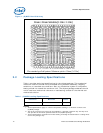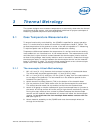
Product Specifications
Thermal and Mechanical Design Guidelines 13
2.3 Thermal Specifications
To ensure proper operation and reliability of the (G)MCH, the temperature must be at
or below the maximum value specified in
Table 2. System and component level
thermal enhancements are required to dissipate the heat generated and maintain the
(G)MCH within specifications. Chapter
3 provides the thermal metrology guidelines for
case temperature measurements.
The (G)MCH must also operate above the minimum case temperature specification
listed in Table 2.
Table 2. (G)MCH Case Temperature Specifications
Parameter Value
T
C-MAX
82945G/82945GZ/82945GC GMCH: 99 °C
82945P/82945PL MCH : 103°C
T
C-MIN
0 °C
NOTE: Thermal specifications assume an attached heatsink is present.
2.4 Thermal Design Power (TDP)
Thermal design power (TDP) is the estimated power dissipation of the (G)MCH based
on normal operating conditions including V
CC
and T
C-MAX
while executing real worst-
case power intensive applications. This value is based on expected worst-case data
traffic patterns and usage of the (G)MCH and does not represent a specific software
application. TDP attempts to account for expected increases in power due to variation
in (G)MCH current consumption due to silicon process variation, processor speed,
DRAM capacitive bus loading and temperature. However, since these variations are
subject to change, the TDP cannot ensure that all applications will not exceed the TDP
value.
The system designer must design a thermal solution for the (G)MCH such that it
maintains T
C
below T
C-MAX
for a sustained power level equal to TDP. Note that the T
C-
MAX
specification is a requirement for a sustained power level equal to TDP, and that
the case temperature must be maintained at temperatures less than T
C-MAX
when
operating at power levels less than TDP. This temperature compliance is to ensure
(G)MCH reliability over its useful life. The TDP value can be used for thermal design if
the (G)MCH thermal protection mechanisms are enabled. Intel chipsets incorporate a
hardware-based fail-safe mechanism to help keep the product temperature within
specifications in the event of unusually strenuous usage above the TDP power limit.


















